
Wine Culture and Information since 2002 - Volume 22
 Wine Culture and Information since 2002 - Volume 22 |
|
Cabernet Sauvignon, Merlot and Pinot NoirThree classic grapes of French origin, everywhere considered international, tell this month their stories in the glasses of our comparative tasting |
|
After the comparative tasting about aromatic white grapes, this month we will study three red berried varieties, known since many years in every wine producing country of the world and considered as international, important symbols of French enology. This month's tasting will examine Cabernet Sauvignon and Merlot - whose origin is from Bordeaux and widely used for the production of wines all over the world - as well as Pinot Noir, emblem of red wines in Bourgogne. Whereas Cabernet Sauvignon and Merlot have conquered the vineyards in every country of the world - frequently used together with local grapes - Pinot Noir still possesses higher personality, even because of the difficulty in the cultivation and vinification of this grape. Grapes producing truly different wines and it will be interesting to discover their characteristics and specific qualities. Cabernet Sauvignon, Merlot and Pinot Noir are everywhere considered grapes capable of producing elegant and important wines, however the personality of each will let them express a truly different elegance one from each other. Cabernet Sauvignon undeniably represents power, Merlot smoothness and Pinot Noir elegant class. Grapes producing wines with different structures to which contributes the use of casks and barriques as well. The goal of our comparative tasting - besides studying the specific qualities of each grape - is to understand how every grape gives different structure to wine, different organoleptic qualities - not only aromatic - as well as different gustatory evolution. We will discover, for example, how the pleasing acidity of Pinot Noir contributes to its elegance, whereas roundness will be the charming side of Merlot, as well as the appreciable astringency of tannins will give Cabernet Sauvignon its typical body.
|
|
The wines selected for our comparative tasting will be produced with the three grapes - Cabernet Sauvignon, Merlot and Pinot Noir - alone, that is the wines will be mono varietals. The wine making techniques used for the production of these wines - all being aged in cask - will let us understand how wood influences the many organoleptic qualities. We will understand how wood is being used in different ways according to the type of grape - more intense for Cabernet Sauvignon and Merlot, lighter for Pinot Noir - while giving, in many aspects, the typicality generally recognized to the wines produced with these grapes. Another interesting aspect of our tasting is the study of organoleptic similarities in Cabernet Sauvignon and Merlot, and how Pinot Noir is drastically different from these two renowned varieties.
The wines selected for the tasting offer interesting elements for the goal of our comparison. The first wine we will examine is Produttori Termeno's Alto Adige Pinot Nero Schiesstandhof, an interesting Pinot Noir in which can be found all the typical qualities of the grape and in which is also possible to recognize the effects of wood in the aging. The second wine is Rocca Bernarda's Colli Orientali del Friuli Merlot Centis, interesting example of this renowned grapes and having useful similarities with the third wine, Casale del Giglio's Cabernet Sauvignon. This latter wine has very interesting qualities typical of the grape, an useful characteristic for the purpose of our comparative tasting. In case it is not possible to have the wines we just proposed, we suggest choosing - as an alternative - wines coming from the same areas and aged in barrique. Concerning vintages, it will be chosen the most recent ones. The three wines will be served at a temperature of 18°C (64°F) in three ISO tasting glasses. We can therefore let our tasting begin: let's pour the three wines on the three glasses.
|
||||||||
|
By observing the three wines, it will be noticed that one of them is very different in the aspect from the other two. Whereas color and transparency in Cabernet Sauvignon and Merlot are pretty similar, the aspect of Pinot Noir will show a paler color and a higher transparency. This quality is perfectly corresponding to the type of grape, as well as it is for the other two grapes. Despite a wine having a less intense color and a higher transparency usually makes people believe it is a lesser quality product, this characteristic is absolutely normal and correspondent in wines produced with Pinot Noir. It will be Pinot Noir the first wine we will examine. By holding the glass tilted over a white surface, the color shows a brilliant ruby red color whereas the nuance - which can be observed in the edge of the liquid mass towards the opening of the glass - shows an evident garnet red color. A precise sign which is absolutely coherent with its age, as Produttori Termeno winery usually release this wine after about three years from vintage. The second wine we will examine is Rocca Bernarda's Merlot. In this case the color is evidently more intense and deep as opposed to Pinot Noir, even in this case, absolutely correspondent to the type. It will be observed - by holding the glass tilted over a white surface - a brilliant ruby red color and nuances of garnet red, with a lesser transparency than Pinot Noir. It is good to remember the colorant capacity of Pinot Noir is not high, therefore the comparison with Merlot will directly highlight the qualities of the two grapes. Then, we will observe the color of Casale del Giglio's Cabernet Sauvignon. The color will be intense ruby red, deeper than both Merlot and Pinot Noir, and the nuances will show the same color. This characteristic makes us understand this wine is relatively young - Casale del Giglio release its Cabernet Sauvignon after about three years from vintage - as well as highlighting a higher longevity than Merlot. It should also be remembered the coloring capacity of Cabernet Sauvignon is pretty high, therefore the color in these wines will generally be intense and deep, as opposed to Pinot Noir which has a truly lesser coloring capacity.
|
|
The olfactory comparison of the three wines will be pretty interesting. We will understand, first of all, how Pinot Noir is different from Cabernet Sauvignon and Merlot, which will have in common interesting aromatic analogies. Of the three wines, the one having the more delicate aroma certainly is Pinot Noir: in fact this will be the first wine we will examine. By holding the glass still - that is without swirling it - let's smell Pinot Noir in order to assess its opening aromas. They will be perceived strong aromas of cherry and raspberry, two aromas - and in particular cherry - which are identifying of this variety. After having swirled the glass, let's now smell the glass for the second time: we will discover all other aromas are now accentuated. In this second phase it will be possible to perceive aromas of strawberry jam, dried rose, geranium and plum. This Pinot Noir also have more complex aromas because of the aging in wood - Schiesstandhof ages for 9 months in barrique - such as vanilla, licorice and cocoa. The second wine we will examine is Rocca Bernarda's Colli Orientali del Friuli Merlot Centis. The evaluation of opening aromas - by holding the glass still - will reveal hints of black cherry, plum and black currant, three aromas typical in Merlot - and we will discover in Cabernet Sauvignon as well - therefore the wine is correspondent to the variety. By swirling the glass and by smelling the wine again, it will be perceived an aroma of blueberry as well as an aromatic series typical of the aging in wood - a wine making practice frequent for Merlot and in this case corresponding to 15 months - such as vanilla, licorice, cinnamon and cocoa. This Merlot also offers aromas which could surprise some tasters. In fact they will be perceived aromatic qualities of vegetal origin, in this specific case bell pepper and hay. The aroma of bell pepper can be an identifying quality of Merlot - however it is more typical in Cabernet Sauvignon and in particular in Cabernet Franc - more frequent in case the grape comes from cool climate areas or harvested when not perfectly ripe. The last wine we will examine is Casale del Giglio's Cabernet Sauvignon. In this wine the opening aromas, appreciable by holding the glass still, will reveal hints of black cherry and black currant, a quality which we have already found in Merlot and which is absolutely typical - as well as plum - in Cabernet Sauvignon. The second smell - done by swirling the glass - will reveal aromas of plum, violet and blackberry as well as aromas derived from the aging in wood - for this wine is about 20 months in barrique - such as vanilla, licorice and cocoa. It will also be noticed a clean aroma of bell pepper, already found in Merlot, which is to be considered a peculiarity of Cabernet grapes. Other aromas emerging from the glass include tobacco and hints of leather. Finally it will be noticed an “unusual” aroma with a strong balsamic nature: it is eucalyptus, an aroma which generally develops with the aging in barrique and which is frequently found in Cabernet Sauvignon.
|
||||
|
During the gustatory analysis, the three wines will reveal their differences instead of their similarities. The first wine we will taste is Pinot Noir. The first impact will reveal one of the qualities making this grape unique, an appreciable acidity - which does not disturb at all and which gives the wine a good elegance - as well as an appreciable astringency because of tannins. These characteristics are absolutely typical in Pinot Noir, and in particular its not excessive astringency as the grape does not have high quantity of tannins. It will also be noticed an appreciable alcohol volume and how it is useful in keeping the wine's acidity perfectly balanced. It will also be noticed a good smoothness, as the result of the aging in wood. Let's examine the structure of this wine: a characteristic we will compare with the other two wines. In the mouth will be perceived flavors of cherry, raspberry and strawberry, therefore confirming its correspondence to the nose. The second wine we will examine is Merlot. The sensations perceived in the mouth will completely be different from Pinot Noir. In this wine it is smoothness the quality which is perceived in the beginning, the structure is evidently higher as well as the astringency of tannins. Smoothness is in fact one of the main qualities of Merlot and which are easily appreciated, for this reason it is frequently used for assembling wines in order to make them rounder and less harsh. In the mouth this Merlot will confirm its correspondence to the nose: it will be possible to perceive flavors of plum, black cherry and black currant. After that, we will proceed by tasting Cabernet Sauvignon. The impact is very different from the other two wines and here will be the higher structure to be noticed in the beginning - also reinforced by the higher astringency of tannins - while however having a pleasing smoothness because of the aging in barrique. It should also be noticed the alcohol volume and how it contributes in determining the wine's balance. Even this Cabernet Sauvignon confirms its correspondence to the nose by means of the perception of black cherry, plum and black currant flavors, the same perceived in Merlot as well.
|
|
The final sensations the three wines leave in the mouth are different one from another, however in all the three cases, it will be noticed a good taste-olfactory persistence. The finish of Produttori Termeno's Pinot Nero Schiesstandhof will be characterized by pleasing flavors of cherry, raspberry and strawberry, perfectly coherent with its type. The finish of Rocca Bernarda's Merlot Centis will be characterized by flavors of plum, black cherry and black currant, once again, typical qualities of Merlot. It is interesting to notice how the finish of Casale del Giglio's Cabernet Sauvignon will leave in the mouth flavors of black cherry, plum and black currant, however they will be more intense than Merlot, therefore confirming the typical organoleptic qualities of this grape. During the evaluation of finish, it should be examined the impact of structure and astringency: it will be low in Pinot Noir, medium high in Merlot, very high in Cabernet Sauvignon. The end of the tasting will let us understand some similarities in Merlot and Cabernet Sauvignon, as well as the evident differences of Pinot Noir.
|
Wines of the Month |
|
|
|
Score legend Prices are to be considered as indicative. Prices may vary according to the country or the shop where wines are bought |

|
|
Friuli Grave Chardonnay 2004 |
|
| Di Lenardo (Italy) | |
| Grapes: Chardonnay | |
| Price: € 5.00 | Score: |
| The wine shows an intense greenish yellow color and nuances of greenish yellow, very transparent. The nose reveals intense, clean, pleasing and refined aromas that start with hints of banana and acacia followed by aromas of pineapple, litchi, broom, apple and pear. The mouth has good correspondence to the nose, a crisp attack and however balanced, good body, intense flavors. The finish is persistent with flavors of banana, pineapple and pear. This Chardonnay ages in steel tanks for 5 months. | |
| Food Match: Fried fish, Pasta and risotto with fish and crustaceans, Sauteed fish | |
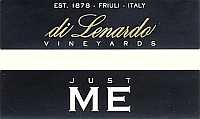
|
|
Just Me 2003 |
|
| Di Lenardo (Italy) | |
| Grapes: Merlot | |
| Price: € 15.00 | Score: |
| This wine shows an intense ruby red color and nuances of ruby red, little transparency. The nose reveals intense, clean, pleasing and refined aromas which start with hints of black cherry, plum and black currant followed by aromas of coconut, blueberry, violet, licorice, eucalyptus, cocoa and vanilla. The mouth has good correspondence to the nose, a tannic attack and however balanced by alcohol, good body, intense flavors, good tannins. The finish is persistent with flavors of black cherry, plum and black currant. Just Me ages for 18 months in barrique followed by 3 months of aging in bottle. | |
| Food Match: Stewed and braised meat, Roasted meat, Hard cheese | |
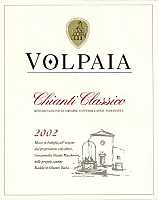
|
|
Chianti Classico 2002 |
|
| Castello di Volpaia (Italy) | |
| Grapes: Sangiovese | |
| Price: € 10.90 | Score: |
| This Chianti Classico shows a brilliant ruby red color and nuances of ruby red, moderate transparency. The nose denotes intense, clean and pleasing aromas that start with hints of black cherry and plum followed by aromas of pomegranate, cyclamen, strawberry, violet and vanilla. The mouth has good correspondence to the nose, a slightly tannic attack and however balanced by alcohol, good body, intense flavors, good tannins. The finish is persistent with flavors of black cherry and plum. This Chianti Classico ages in cask for about 14 months. | |
| Food Match: Broiled meat and barbecue, Stewed meat, Sauteed meat, Stuffed pasta | |
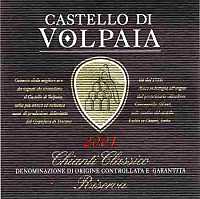
|
|
Chianti Classico Riserva 2001 |
|
| Castello di Volpaia (Italy) | |
| Grapes: Sangiovese (90%), Merlot, Pinot Noir, Syrah (10%) | |
| Price: € 17.20 | Score: |
| This Chianti Classico shows an intense ruby red color and nuances of garnet red, moderate transparency. The nose reveals intense, clean, pleasing and refined aromas which start with hints of black cherry, plum and blackberry followed by aromas of violet, licorice, tobacco, vanilla and cinnamon. The mouth has good correspondence to the nose, a slightly tannic attack and however balanced by alcohol, good body, intense flavors, good tannins. The finish is persistent with flavors of black cherry, plum and blueberry. This Chianti Classico Reserve ages for 24 months in cask. | |
| Food Match: Roasted meat, Broiled meat and barbecue, Stewed and braised meat | |
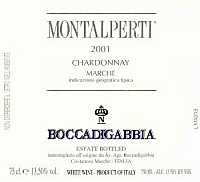
|
|
Montalperti 2001 |
|
| Boccadigabbia (Italy) | |
| Grapes: Chardonnay | |
| Price: € 20.00 | Score: |
| This wine shows an intense straw yellow color and nuances of straw yellow, very transparent. The nose reveals good personality with intense, clean, pleasing and refined aromas which start with hints of jasmine, apple and plum followed by aromas of citrus fruits, banana, pineapple, hawthorn, broom and vanilla. The mouth has good correspondence to the nose, a crisp attack and pleasing roundness, however balanced by alcohol, good body, intense flavors, agreeable. The finish is persistent with flavors of plum and apple. Montalperti ferments and ages for 4-5 months in barrique followed by at least 6 months of aging in bottle. | |
| Food Match: Stewed fish with mushrooms, Roasted fish, Stuffed pasta, Roasted white meat | |
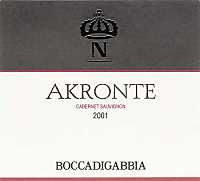
|
|
Akronte 2001 |
|
| Boccadigabbia (Italy) | |
| Grapes: Cabernet Sauvignon | |
| Price: € 40.00 | Score: |
| This wine shows an intense ruby red color and nuances of garnet red, little transparency. The nose reveals intense, clean, pleasing, refined and elegant aromas which start with hints of black cherry, plum and black currant followed by aromas of blueberry, violet, vanilla, licorice, tobacco, bell pepper, black pepper, lavender, cocoa, cinnamon and menthol. The mouth has very good correspondence to the nose, a tannic attack and good roundness, however balanced by alcohol, full body, intense flavors, good tannins, agreeable. The finish is very persistent with long flavors of black currant, black cherry, plum and blueberry. A well made wine. Akronte ages in barrique for 18-20 months. | |
| Food Match: Game, Roasted meat, Stewed and braised meat, Hard cheese | |
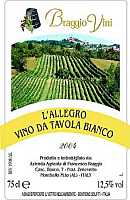
|
|
L'Allegro 2004 |
|
| Braggio (Italy) | |
| Grapes: Cortese | |
| Price: € 4.00 | Score: |
| The wine shows an intense golden yellow color and nuances of straw yellow, transparent. The nose denotes intense and pleasing aromas that start with hints of apple and pear followed by aromas of plum and hawthorn. The mouth has good correspondence to the nose, a crisp attack and however balanced, good body, intense flavors. The finish is pretty persistent with flavors of apple and plum. | |
| Food Match: Vegetables and fish appetizers, Pasta and risotto with vegetables | |
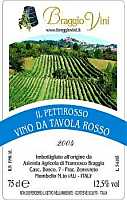
|
|
Il Pettirosso 2004 |
|
| Braggio (Italy) | |
| Grapes: Bonarda | |
| Price: € 4.00 | Score: |
| This wine shows a brilliant ruby red color and nuances of ruby red, moderate transparency. The nose reveals intense and clean aromas which start with hints of cherry, violet and plum followed by aromas of blueberry and raspberry. The mouth has good correspondence to the nose, a slightly tannic attack and appreciable crispness, good body, intense flavors. The finish is persistent with flavors of cherry and raspberry. | |
| Food Match: Sauteed meat, Pasta with meat | |
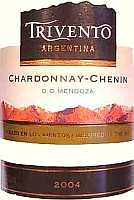
|
|
Chardonnay-Chenin 2004 |
|
| Trivento (Argentina) | |
| Grapes: Chardonnay (50%), Chenin Blanc (50%) | |
| Price: € 4.50 | Score: |
| The wine shows a brilliant straw yellow color and nuances of straw yellow, very transparent. The nose denotes intense, clean and pleasing aromas which start with hints of banana and pear followed by aromas of hawthorn, acacia, broom, lemon and peach. The mouth has good correspondence to the nose, a crisp attack and pleasing roundness, however balanced by alcohol, good body, intense flavors. The finish is pretty persistent with flavors of banana and peach. This wine ages in steel tanks. | |
| Food Match: Aperitifs, Fish and crustaceans appetizers, Pasta and risotto with vegetables | |
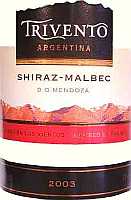
|
|
Shiraz-Malbec 2004 |
|
| Trivento (Argentina) | |
| Grapes: Syrah (50%), Malbec (50%) | |
| Price: € 4.50 | Score: |
| The wine shows a brilliant ruby red color and nuances of ruby red, moderate transparency. The nose denotes intense, clean and pleasing aromas that start with hints of plum and raspberry followed by aromas of black cherry, blueberry, black currant and hints of black pepper. The mouth has good correspondence to the nose, a slightly tannic attack and however balanced by alcohol, good body, intense flavors, good tannins. The finish is pretty persistent with flavors of plum and blueberry. This wine ages in steel tanks. | |
| Food Match: Sauteed meat, Cold cuts, Stuffed pasta | |

|
|
Bianco di Custoza Superiore Campo del Selese 2003 |
|
| Albino Piona (Italy) | |
| Grapes: Garganega (30%), Trebbiano Toscano (30%), Chardonnay (30%), Tocai Friulano (10%) | |
| Price: € 9.50 | Score: |
| The wine shows an intense golden yellow color and nuances of golden yellow, very transparent. The nose reveals good personality with intense, clean, pleasing, refined and elegant aromas which start with hints of apricot, pear and apple followed by aromas of citrus fruits, banana, broom, litchi, honey, hazelnut, peach and hints of vanilla. The mouth has good correspondence to the nose, a crisp attack and pleasing smoothness, however balanced by alcohol, good body, intense flavors, agreeable. The finish is persistent with flavors of apricot, banana and pear. A well made wine. Campo del Selese is produced with overripe grapes, a part of this wine ages for 9 months in barrique and ages for 4 months in bottle. | |
| Food Match: Roasted fish, Broiled fish, Stuffed pasta, Roasted white meat | |

|
|
Bianco di Custoza Passito La Rabitta 2002 |
|
| Albino Piona (Italy) | |
| Grapes: Garganega, Cortese, Riesling, Trebbiano Toscano | |
| Price: € 19.00 - 50cl | Score: |
| This wine shows a pale amber yellow color and nuances of amber yellow, transparent. The nose reveals intense, clean, pleasing, refined and elegant aromas which start with hints of dried fig, raisin and date followed by aromas of candied fruit, peach jam, almond, honey, quince, lavender, walnut and vanilla. The mouth has good correspondence to the nose, a sweet and smooth attack, however balanced by alcohol, good body, intense flavors, agreeable. The finish is persistent with flavors of dried fig, peach jam, raisin and honey. A well made wine. La Rabitta ferments and ages in barrique for 12 months followed by 4 months of aging in bottle. | |
| Food Match: Hard cheese, Dried fruit tarts | |
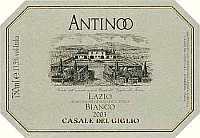
|
|
Antinoo 2003 |
|
| Casale del Giglio (Italy) | |
| Grapes: Chardonnay (66%), Viognier (34%) | |
| Price: € 9.00 | Score: |
| The wine shows an intense straw yellow color and nuances of straw yellow, very transparent. The nose denotes intense, clean, pleasing and refined aromas which start with hints of banana, apple and plum followed by aromas of pineapple, grapefruit, hawthorn, toasted wood, vanilla, hazelnut and praline. The mouth has good correspondence to the nose, a crisp attack and pleasing roundness, however well balanced by alcohol, good body, intense flavors, agreeable. The finish is persistent with flavors of plum, banana, pineapple and apple. A well made wine. Antinoo ages in barrique for 6-8 months followed by 6-12 months of aging in bottle. | |
| Food Match: Stuffed pasta with mushrooms, Roasted fish, Roasted white meat | |
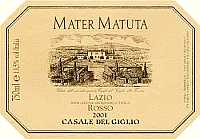
|
|
Mater Matuta 2001 |
|
| Casale del Giglio (Italy) | |
| Grapes: Syrah (85%), Petit Verdot (15%) | |
| Price: € 24.00 | Score: |
| This wine shows an intense ruby red color and nuances of garnet red, little transparency. The nose reveals intense, clean, pleasing, refined and elegant aromas which start with hints of black cherry, black currant, plum and blackberry followed by aromas of blueberry, violet, vanilla, licorice, tobacco, black pepper, cocoa, cinnamon and eucalyptus. The mouth has very good correspondence to the nose, a tannic attack and good roundness, however balanced by alcohol, full body, intense, flavors, good tannins, agreeable. The finish is very persistent with long flavors of black currant, black cherry, plum and blueberry. A well made wine. Mater Matuta ages for 22-24 months in barrique followed by 6-8 months of aging in bottle. | |
| Food Match: Game, Roasted meat, Braised and stewed meat, Hard cheese | |
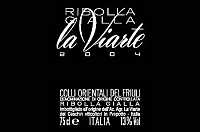
|
|
Colli Orientali del Friuli Ribolla Gialla 2004 |
|
| La Viarte (Italy) | |
| Grapes: Ribolla Gialla | |
| Price: € 11.30 | Score: |
| The wine shows a pale straw yellow color and nuances of greenish yellow, very transparent. The nose denotes intense, clean, pleasing and refined aromas which start with hints of apple, plum and hawthorn followed by aromas of broom, acacia, pineapple, pear and yeast. The mouth has good correspondence to the nose, a crisp attack and however well balanced by alcohol, good body, intense flavors, agreeable. The finish is persistent with flavors of pear, apple and plum. This Ribolla Gialla ages for 7 months in steel tanks. | |
| Food Match: Fried fish, Crustaceans appetizers, Pasta and risotto with fish and crustaceans, Sauteed fish | |
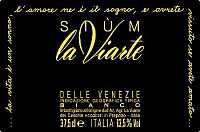
|
|
Siùm 2001 |
|
| La Viarte (Italy) | |
| Grapes: Picolit, Verduzzo Friulano | |
| Price: € 19.50 - 375ml | Score: |
| This wine shows a brilliant amber yellow color and nuances of amber yellow, transparent. The nose reveals intense, clean, pleasing, refined and elegant aromas which start with hints of dried fig, honey and quince jam followed by aromas of apricot jam, peach jam, caramel, date, almond, lavender, hazelnut and vanilla. The mouth has good correspondence to the nose, a sweet attack and pleasing smoothness, however balanced by alcohol, good body, intense flavors, agreeable. The finish is persistent with flavors of dried fig, peach jam, apricot jam and honey. A well made wine. Siùm ferments and ages in barrique for at least two years followed by at least 6 months of aging in bottle. | |
| Food Match: Hard cheese, Confectionery, Dried fruit tarts | |
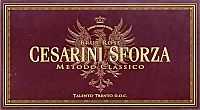
|
|
Talento Trento Cuvée Brut Rosé |
|
| Cesarini Sforza (Italy) | |
| Grapes: Pinot Noir | |
| Price: € 12.40 | Score: |
| This wine shows a brilliant salmon pink color and nuances of onion skin pink, very transparent, good effervescence, fine and persistent perlage. The nose reveals intense, clean, pleasing and refined aromas which start with hints of raspberry, cherry and strawberry followed by aromas of bread crust, banana, yeast, pear, rose and plum. The mouth has good correspondence to the nose, an effervescent and crisp attack, however balanced by alcohol, good body, intense flavors, agreeable. The finish is persistent with flavors of raspberry, strawberry and cherry. Part of the base wine used for this Talento ages in cask. It ages for 36 months on its lees. | |
| Food Match: Stuffed pasta with mushrooms, Roasted fish, Stewed fish, Roasted white meat | |
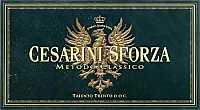
|
|
Talento Trento Classico Millesimato 2000 |
|
| Cesarini Sforza (Italy) | |
| Grapes: Chardonnay (80%), Pinot Noir (20%) | |
| Price: € 12.10 | Score: |
| This Talento shows a pale straw yellow color and nuances of greenish yellow, very transparent, good effervescence, fine and persistent perlage. The nose reveals intense, clean, pleasing and refined aromas which start with hints of pear, apple and pineapple followed by aromas of acacia, hawthorn, banana, bread crust, yeast, hazelnut and grapefruit. The mouth has good correspondence to the nose, an effervescent and crisp attack, however balanced by alcohol, good body, intense flavors, agreeable. The finish is persistent with flavors of pear, pineapple and banana. A small part of the base wine used for this Talento ferments in cask. It ages for 24-36 months on its lees. | |
| Food Match: Stuffed pasta with mushrooms, Broiled fish, Roasted white meat | |
|
||||||||
|
DiWineTaste Polls
|
| |||||||
Privacy Policy | |||||||


| Copyright © 2002-2024 Antonello Biancalana, DiWineTaste - All rights reserved |
| All rights reserved under international copyright conventions. No part of this publication and of this WEB site may be
reproduced or utilized in any form or by any means, electronic or mechanical, without permission in writing from DiWineTaste. |